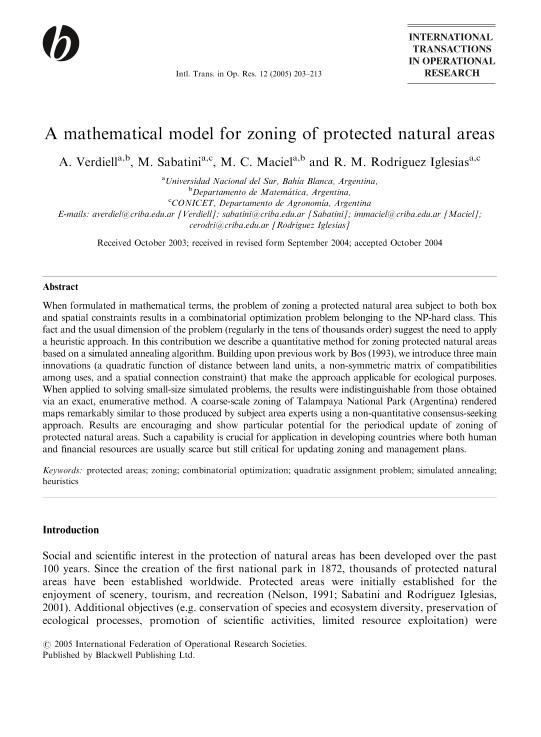Artículo
A mathematical model for zoning of protected natural areas
Fecha de publicación:
04/2005
Editorial:
Blackwell Publishing
Revista:
International Transactions in Operational Research
ISSN:
0969-6016
Idioma:
Inglés
Tipo de recurso:
Artículo publicado
Clasificación temática:
Resumen
When formulated in mathematical terms, the problem of zoning a protected natural area subject to both box and spatial constraints results in a combinatorial optimization problem belonging to the NP-hard class. This fact and the usual dimension of the problem (regularly in the tens of thousands order) suggest the need to apply a heuristic approach. In this contribution we describe a quantitative method for zoning protected natural areas based on a simulated annealing algorithm. Building upon previous work by Bos (1993), we introduce three main innovations (a quadratic function of distance between land units, a non-symmetric matrix of compatibilities among uses, and a spatial connection constraint) that make the approach applicable for ecological purposes. When applied to solving small-size simulated problems, the results were indistinguishable from those obtained via an exact, enumerative method. A coarse-scale zoning of Talampaya National Park (Argentina) rendered maps remarkably similar to those produced by subject area experts using a non-quantitative consensus-seeking approach. Results are encouraging and show particular potential for the periodical update of zoning of protected natural areas. Such a capability is crucial for application in developing countries where both human and financial resources are usually scarce but still critical for updating zoning and management plans.
Archivos asociados
Licencia
Identificadores
Colecciones
Articulos(CCT - BAHIA BLANCA)
Articulos de CTRO.CIENTIFICO TECNOL.CONICET - BAHIA BLANCA
Articulos de CTRO.CIENTIFICO TECNOL.CONICET - BAHIA BLANCA
Citación
Verdiell, Adriana Beatriz; Sabatini, M.; Maciel, Maria Cristina; Rodríguez Iglesias, Ricardo Manuel; A mathematical model for zoning of protected natural areas; Blackwell Publishing; International Transactions in Operational Research; 12; 2; 4-2005; 203-213
Compartir
Altmétricas




